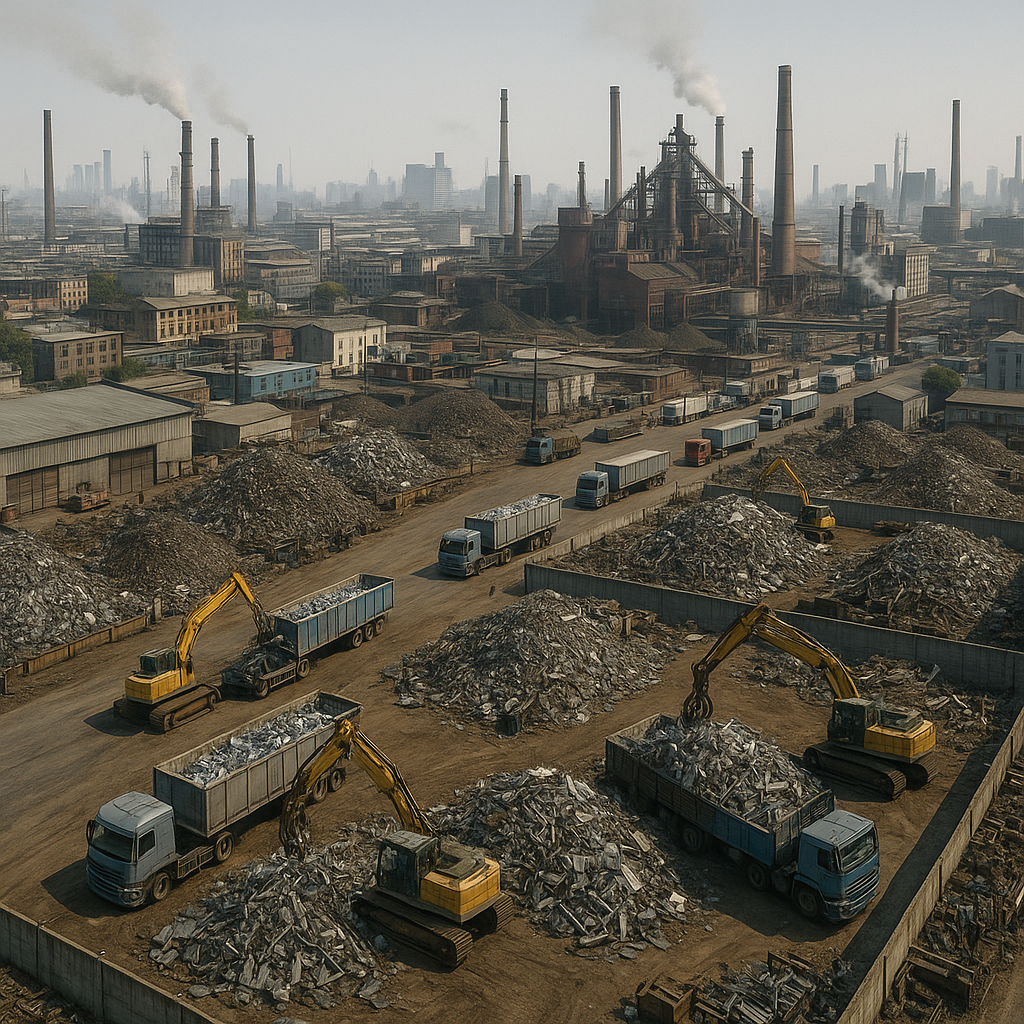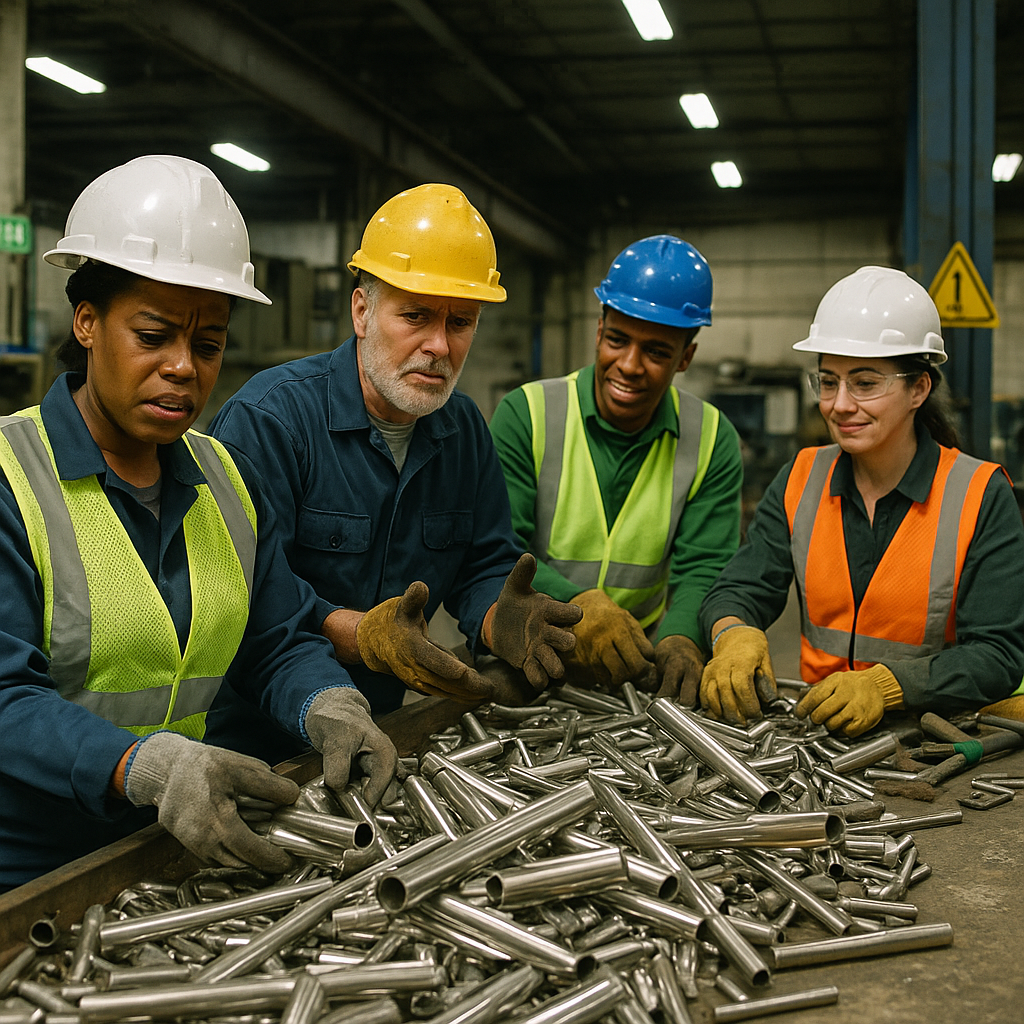5901 Botham Jean Blvd, Dallas, TX 75215
Learn the Current Trends in Stainless Steel Scrap Prices
September 18, 2025The global stainless steel scrap market, valued at USD 206.91 billion in 2023, is projected to reach USD 320.37 billion by 2032. This significant growth highlights the material’s enduring value in the global recycling economy. With a compound annual growth rate of 5.0%, stainless steel scrap remains a vital resource for manufacturing and construction sectors worldwide.
Market prices for stainless steel scrap exhibit an oscillatory pattern influenced by several key factors. Price variability primarily arises from fluctuations in raw material costs, notably nickel, chromium, and molybdenum. These essential components directly affect the overall value of recycled stainless steel across different grades and regions.
Circular economy practices significantly drive this growth. As industries worldwide adopt more sustainable production methods, demand for recycled stainless steel has intensified. This shift reduces environmental impact while maintaining the exceptional quality and durability that make stainless steel invaluable for numerous applications.
How Do Regional Factors Impact Stainless Steel Scrap Prices?

Stainless steel scrap prices exhibit significant regional variations driven by local market dynamics, trade policies, and economic conditions. These regional factors create distinct price trends across Asia, Europe, and North America, resulting in notable price differentials that can impact recycling strategies and procurement decisions.
Asian Market: Chinese Demand and Supply Constraints
The Asian stainless steel scrap market is dominated by China, which displays several distinct characteristics:
- Chinese production dominance: China accounts for 62.8% of global stainless steel production as of 2023, making it the primary driver of regional scrap demand.
- Supply limitations: Kazakhstan’s extended ban on scrap exports for six months has caused material shortages, pushing premium grade prices up by more than 2% in mid-March 2025.
- Inventory reductions: Stockpiles at major trading hubs have declined as processors accelerate purchasing to secure material ahead of anticipated further price increases.
- Nickel price influence: Nickel-bearing stainless grades command higher premiums due to the steady strengthening of nickel values on the Shanghai Futures Exchange.
Despite these upward pressures, the Chinese stainless steel market experienced a 4.5% decline in scrap prices in early 2025, dropping to $325.8 per ton. This contradiction stems from weakened demand from steel mills reducing scrap purchases ahead of the Chinese New Year and high inventory levels.
European Market: Rising Prices Amid Supply Shortages
European stainless steel scrap values have moved decisively upward, influenced by several regional factors:
- Rising LME copper prices: The increase has created positive sentiment across all non-ferrous recycling segments, supporting higher stainless scrap values.
- German market strength: German scrap dealers report significant increases for V-2A and V-4A stainless grades, reflecting rising alloy surcharges and tightening availability.
- Regulatory support: The European Commission’s ongoing review of trade measures indirectly supports scrap values by maintaining firm pricing for finished stainless products.
- High-nickel preferences: Processors are focusing on high-nickel content grades where material utilization offers maximum revenue potential.
In early 2025, Germany saw scrap prices (E3, ex-works) reach €302.5 per ton, marking a 1.7% increase since December 2024. Italy experienced an even stronger recovery with prices for E8-grade scrap rising to €345 per ton, up 2.2% compared to the end of 2024.
North American Market: Domestic Demand and Trade Policies
North American stainless steel scrap prices have surged dramatically, influenced by both domestic and international factors:
- Tariff implementation: Broad tariffs on steel imports have strengthened the position of domestic mills, increasing their scrap purchasing activity.
- Below-average collection rates: Supply remains below historical averages, creating competitive pressure among buyers seeking to secure limited materials.
- Widening price differentials: The price gap between 300-series and 400-series scrap has expanded significantly as nickel content becomes increasingly valuable.
- Weather disruptions: Heavy snowfall in key states has slowed down scrap procurement and transportation, further limiting supply.
- Premium payment practices: Processors report extending payment premiums to secure reliable supply streams, particularly for cleanly segregated industrial arisings with higher alloy content.
Since early 2025, scrap prices in the U.S. have risen by 4.3%, reaching $330.5 per ton (US East Coast FOB). The major increase occurred in early January, driven by adverse weather conditions, potential dockworker strikes causing supply uncertainties, and strong demand from domestic steel mills despite weak export markets.
Global Factors Affecting Regional Price Variations
Several overarching factors contribute to regional price differences in the stainless steel scrap market:
- Transportation costs: Elevated freight costs curtail imports from Asia to Europe, further depleting inventories and supporting higher European prices.
- Currency fluctuations: The EUR/USD exchange rate plays a crucial role in determining scrap import costs, with a stronger Euro limiting price declines in European markets.
- Raw material costs: Fluctuations in nickel, chromium, and molybdenum prices directly impact regional stainless steel scrap valuations, creating price variations between markets with different supply access.
- Trade restrictions: Export bans, tariffs, and other protectionist measures significantly impact global supply chains, creating regional price disparities.
These regional variations highlight the importance of understanding local market conditions when developing recycling strategies, procurement plans, or trading approaches in the stainless steel scrap market. The interconnected yet distinct regional pricing patterns create both challenges and opportunities for market participants.
What Are the Key Drivers of Stainless Steel Scrap Prices?

Stainless steel scrap prices fluctuate based on a complex interplay of market forces. Understanding these drivers helps recycling stakeholders manage market volatility and make informed decisions. Let’s examine the key factors influencing these prices.
Raw Material Composition and Values
The metallurgical value of contained metals plays a crucial role in determining scrap prices. Nickel and chromium content typically accounts for 60-70% of the total scrap value. Grade 304 stainless steel, containing 8-9% nickel, commands higher prices than lower-nickel alternatives like 400-series grades.
Price movements in primary metals markets directly impact scrap valuations. When LME nickel prices surged in early 2022 following the Russia-Ukraine conflict, stainless steel scrap prices in Europe peaked at €2,576 per ton before dropping significantly as market conditions stabilized.
Global Circular Economy Initiatives
The growing emphasis on circular economy principles has strengthened the position of stainless steel scrap in the global supply chain. Countries with developed circular economies like Japan and South Korea maintain high scrap utilization rates in stainless steel production, creating consistent demand for quality materials.
This trend is reflected in changing production practices. The global austenitic stainless steel scrap ratio increased to just above 37% in 2021, then declined slightly to around 33% by 2023 due to reduced scrap usage in China and low ratios in Indonesia.
Supply-Demand Dynamics
Regional supply-demand imbalances significantly impact pricing. India remained the largest net importer of stainless steel scrap in 2023, bringing in over 1,300 kilotons as domestic generation couldn’t meet production needs. Meanwhile, Germany was the largest net exporter at 731 kilotons, reflecting its developed collection infrastructure.
Supply constraints often override economic considerations. Even when scrap-based production faces cost disadvantages compared to primary nickel inputs, tight supply conditions can maintain firm pricing as suppliers resist selling at lower values.
Technological Advancements in Processing
Improvements in scrap sorting and processing technology have expanded the range of applications where scrap inputs meet quality requirements. Modern separation techniques allow for better recovery of valuable components and reduce contamination issues that previously limited usability.
These advancements help maintain competitive pricing even as quality demands increase. More efficient processing also reduces the cost gap between scrap-based and primary material production routes, supporting scrap values during market fluctuations.
Policy and Regulatory Influences
Government policies significantly impact stainless steel scrap markets. Export restrictions like Kazakhstan’s extended scrap export ban create supply disruptions that ripple through global markets. Similarly, growing protectionist measures in countries like the UAE and anticipated actions by the EU have tightened supply and supported higher prices.
Environmental regulations increasingly influence market positioning. As sustainability becomes a priority, stainless steel’s long lifespan and recyclability enhance its value compared to less environmentally friendly alternatives, creating structural support for scrap values.
End-Use Industry Demand
Demand from key consuming sectors drives market dynamics. The construction industry uses stainless steel extensively for weather-resistant materials, while the automotive sector values its strength and lightweight properties for improving fuel efficiency and safety.
Specialized sectors like renewable energy are creating new demand sources as stainless steel is used in solar panel mounting systems and wind turbine components. The growth in these industries puts upward pressure on scrap valuations.
Energy and Transportation Costs
Energy expenses significantly impact stainless steel scrap economics. Processing costs are directly affected by energy prices, influencing the final market value. In early 2023, lower energy costs in Western Europe helped maintain some price stability despite other market pressures.
Transportation bottlenecks and increased logistics costs complicate collection networks, creating regional imbalances where materials in some areas remain unavailable while processors elsewhere face shortages. These logistical challenges can maintain price premiums in underserved regions.
By understanding these key drivers, recycling stakeholders can better anticipate market movements and develop strategies to navigate the volatile yet essential stainless steel scrap market.
What Are the Challenges and Opportunities in the Stainless Steel Scrap Market?
Addressing Market Challenges
The stainless steel scrap market faces several significant hurdles that impact profitability and operational efficiency. One pressing issue is the fragmented collection infrastructure present in many regions. Unlike organized recycling systems for common materials, stainless steel scrap often moves through a variety of small-scale collectors, informal gatherers, and regional processors before reaching major recycling facilities.
Price volatility is another substantial challenge for market participants. Current data shows steel scrap trading between $350 and $550 per ton globally, but these prices can fluctuate dramatically due to shifting economic conditions. When the Chinese economy experienced a manufacturing slowdown in early 2023, scrap prices dropped nearly 15% in just six weeks, leaving many suppliers with devalued inventory.
Contamination issues also plague the industry, directly affecting material value. Non-metallic attachments, coatings, and mixed alloy types can significantly reduce the price paid for stainless steel scrap. High-grade 300 series stainless can earn up to $0.35 per pound when clean, but this value plummets when contaminated.
Export restrictions further complicate the global market. More than 25 countries have implemented various limitations on steel scrap exports, ranging from complete bans to significant export taxes. China’s 40% tariff on stainless scrap exports is one of the most impactful trade barriers affecting global supply chains.
Emerging Opportunities
Despite these challenges, significant opportunities are emerging across the stainless steel scrap landscape. Developing economies in Southeast Asia, Africa, and parts of Latin America represent untapped potential for market expansion. As these regions industrialize, they generate increasing volumes of end-of-life stainless steel from construction, transportation, and consumer durables.
Technological advancements in sorting and processing are transforming how scrap is handled. Sensor-based sorting systems and X-ray fluorescence (XRF) technology now allow recyclers to identify specific stainless steel grades with remarkable precision. These innovations help address contamination concerns while improving material recovery rates.
The growing demand for sustainable materials presents a significant opportunity. With industries adopting green procurement policies and tracking lifecycle emissions, stainless steel scrap has become essential for meeting sustainability objectives. Using scrap in steel production typically reduces energy consumption by 60% and cuts CO2 emissions by up to 70% compared to virgin material production.
Digital platforms are also reshaping how scrap is bought and sold. Online marketplaces connect buyers and sellers directly, improving price transparency and market efficiency. These platforms enhance traceability, allowing manufacturers to verify the source and quality of recycled materials used in their products.
Industry Adaptations
Forward-thinking companies are implementing innovative strategies to overcome market challenges. Schnitzer Steel Industries has invested heavily in AI-assisted alloy recognition technology that can rapidly sort various stainless steel grades, reducing processing costs while improving the purity of their recovered materials.
Recyclers are focusing on high-grade scrap for critical applications. Companies like Oryx Stainless AG specialize in producing custom stainless steel blends from scrap for high-value applications in aerospace, medical devices, and food processing equipment. This specialization helps insulate them from price volatility in the broader market.
Regional processing hubs are emerging to address fragmented collection systems. In India, the establishment of collection centers following the Steel Scrap Recycling Policy of 2019 aims to reduce India’s dependence on scrap imports while formalizing the domestic recycling sector.
Some businesses are vertically integrating operations to maintain quality control throughout the recycling process. ArcelorMittal has expanded its recycling division to secure reliable streams of high-quality stainless steel scrap for its manufacturing operations, mitigating supply chain risks and ensuring consistent material quality.
The transition to low-carbon steel production methods further enhances the value of stainless steel scrap. Electric Arc Furnace (EAF) technology, which primarily uses scrap as input material, is gaining traction as steel producers seek to reduce their carbon footprint. This shift signifies a structural change in steel production, with significant long-term implications for scrap demand.
As recycling technologies continue to improve and sustainability pressures mount, the stainless steel scrap market is poised for continued growth despite its challenges. The industry’s ability to adapt through innovation, consolidation, and strategic partnerships will determine which participants thrive in this evolving landscape.
Conclusion: The Future of Stainless Steel Scrap Prices

The stainless steel scrap market shows promising growth potential despite current fluctuations. Global sustainability initiatives drive demand for recycled materials, positioning stainless steel scrap as an increasingly valuable commodity. The industry’s commitment to reducing carbon footprints and conserving natural resources aligns with worldwide environmental goals, creating long-term market stability.
Advancements in sorting and processing methods are transforming the industry. Innovations in artificial intelligence and automation are enhancing the efficiency and purity of recovered materials, making recycled stainless steel more competitive with virgin materials. These improvements increase recovery rates and enhance the quality of recycled stainless steel, opening new market opportunities across various sectors.
For industry stakeholders, staying informed about regional price variations and global market trends is essential for strategic decision-making. The stainless steel scrap market continues to adapt remarkably to economic pressures and supply chain challenges. Those who carefully monitor these developments will be best positioned to navigate the industry’s dynamic landscape. For your recycling needs or to learn more about current stainless steel scrap prices, contact Okon Recycling at 214-717-4083.
